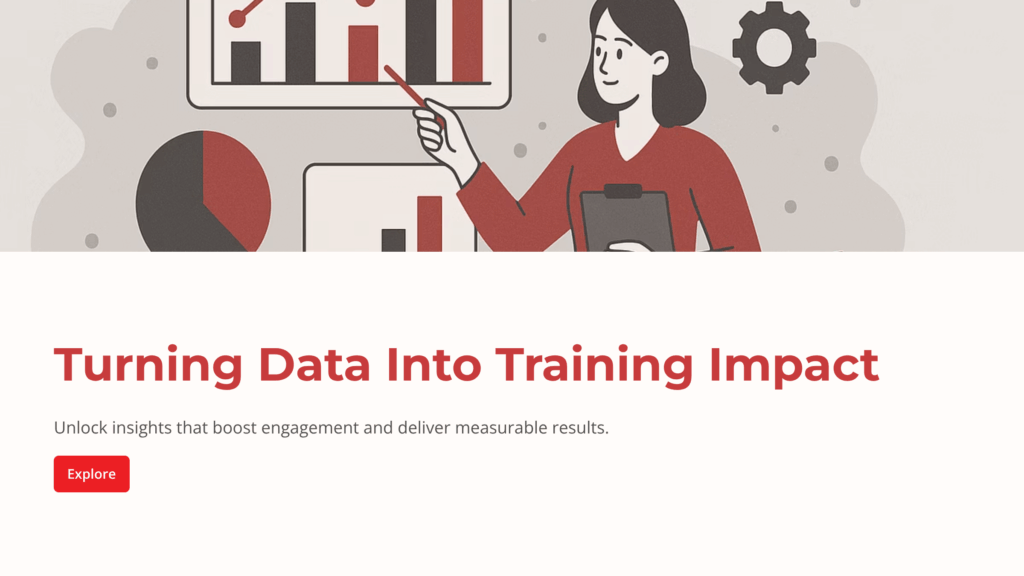
Organisations are investing more than ever in training programmes, but a familiar challenge remains: proving that those investments deliver measurable results. Very often, engagement slips, completion rates falter, and the link between learning and business performance becomes difficult to demonstrate. For training managers and HR leaders under pressure to show impact, this can feel like a frustrating gap between effort and outcome.
Learning analytics offers a powerful way forward. When leaders can transform data into meaningful insights, they can see not just who is participating in training, but how learners are engaging, where they are struggling, and how knowledge is being applied in the workplace. Used strategically, performance metrics provide the evidence to refine programmes, personalise experiences, and clearly demonstrate training ROI.
Why Training ROI Matters in 2025
Investment in corporate learning is no longer judged solely by participation numbers or completion rates. Senior leaders expect clear evidence that training contributes to measurable business outcomes (improved productivity, stronger compliance, enhanced employee retention, and ultimately, profitability).
Yet, demonstrating ROI remains one of the greatest challenges for learning and development (L&D) teams. Engagement may look healthy on the surface, but without connecting learning to on-the-job behaviours and performance, it is difficult to prove value. As a result, training initiatives risk being sidelined when budgets tighten.
The shift towards data-driven decision-making across every business function has raised expectations in L&D. Leaders are asking not only “Did people complete the course?” but also “What difference did it make?” This demand for accountability makes ROI measurement essential. It is no longer enough to assume that training adds value; organisations must show it through robust evidence.
Practical Steps to Implement Learning Analytics
Moving from theory to practice requires a structured approach. Learning analytics is most effective when it is built into the design of a training strategy, not added as an afterthought. The following steps provide a framework for organisations ready to use data to improve engagement and demonstrate ROI:
1. Define Clear Objectives and KPIs
Begin by identifying what success looks like. Is the goal to improve compliance rates, reduce onboarding time, or increase productivity in specific roles? Setting measurable KPIs aligned to organisational priorities ensures analytics focus on the outcomes that matter most to stakeholders.
2. Select the Right Tools and Platforms
Learning management systems (LMS) and learning experience platforms (LXP) increasingly offer built-in analytics dashboards. However, the right tool depends on the complexity of your data needs. Consider whether you need basic completion data, deeper engagement insights, or advanced predictive analytics powered by AI.
3. Integrate Data Sources
For a complete picture, combine training data with business performance metrics such as sales figures, safety records, or employee retention rates. Integration bridges the gap between learning activity and workplace outcomes, making ROI visible.
4. Foster a Culture of Continuous Improvement
Analytics should not be a one-off reporting exercise. Regularly review insights to identify what’s working, where learners are disengaging, and how programmes can be refined. Embedding a cycle of testing, feedback, and adaptation helps learning remain relevant and impactful.
5. Address Ethical and Privacy Considerations
Responsible use of analytics is as important as accuracy. Learners should feel confident that their data is being used to support development rather than to penalise performance. Transparent communication and adherence to privacy standards build trust while enabling meaningful insight.
Data-Driven Learning: Turning Data into Lasting Impact
The result of learning analytics implementation is not just better training, but a workforce that is more confident and aligned with strategic goals.
This principle is built into the way Anderson Studios designs learning solutions. Our custom learning management systems (LMSs) are created with robust, built-in reporting tools that give training managers and HR leaders direct visibility into learner progress, engagement trends, and business impact.
Ready to see how data can reshape your training outcomes? Contact Anderson Studios today to explore how our tailored LMS solutions can deliver measurable engagement and ROI for your organisation.

